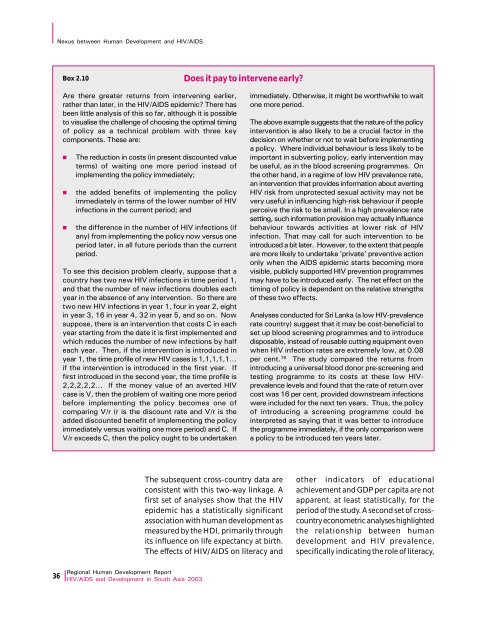Download Report - UNDP Asia-Pacific Regional Centre - United ...
Download Report - UNDP Asia-Pacific Regional Centre - United ...
Download Report - UNDP Asia-Pacific Regional Centre - United ...
You also want an ePaper? Increase the reach of your titles
YUMPU automatically turns print PDFs into web optimized ePapers that Google loves.
Nexus between Human Development and HIV/AIDSBox 2.10Does it pay to intervene early?Are there greater returns from intervening earlier,rather than later, in the HIV/AIDS epidemic? There hasbeen little analysis of this so far, although it is possibleto visualise the challenge of choosing the optimal timingof policy as a technical problem with three keycomponents. These are:nnnThe reduction in costs (in present discounted valueterms) of waiting one more period instead ofimplementing the policy immediately;the added benefits of implementing the policyimmediately in terms of the lower number of HIVinfections in the current period; andthe difference in the number of HIV infections (ifany) from implementing the policy now versus oneperiod later, in all future periods than the currentperiod.To see this decision problem clearly, suppose that acountry has two new HIV infections in time period 1,and that the number of new infections doubles eachyear in the absence of any intervention. So there aretwo new HIV infections in year 1, four in year 2, eightin year 3, 16 in year 4, 32 in year 5, and so on. Nowsuppose, there is an intervention that costs C in eachyear starting from the date it is first implemented andwhich reduces the number of new infections by halfeach year. Then, if the intervention is introduced inyear 1, the time profile of new HIV cases is 1,1,1,1,1…if the intervention is introduced in the first year. Iffirst introduced in the second year, the time profile is2,2,2,2,2… If the money value of an averted HIVcase is V, then the problem of waiting one more periodbefore implementing the policy becomes one ofcomparing V/r (r is the discount rate and V/r is theadded discounted benefit of implementing the policyimmediately versus waiting one more period) and C. IfV/r exceeds C, then the policy ought to be undertakenimmediately. Otherwise, it might be worthwhile to waitone more period.The above example suggests that the nature of the policyintervention is also likely to be a crucial factor in thedecision on whether or not to wait before implementinga policy. Where individual behaviour is less likely to beimportant in subverting policy, early intervention maybe useful, as in the blood screening programmes. Onthe other hand, in a regime of low HIV prevalence rate,an intervention that provides information about avertingHIV risk from unprotected sexual activity may not bevery useful in influencing high-risk behaviour if peopleperceive the risk to be small. In a high prevalence ratesetting, such information provision may actually influencebehaviour towards activities at lower risk of HIVinfection. That may call for such intervention to beintroduced a bit later. However, to the extent that peopleare more likely to undertake ‘private’ preventive actiononly when the AIDS epidemic starts becoming morevisible, publicly supported HIV prevention programmesmay have to be introduced early. The net effect on thetiming of policy is dependent on the relative strengthsof these two effects.Analyses conducted for Sri Lanka (a low HIV-prevalencerate country) suggest that it may be cost-beneficial toset up blood screening programmes and to introducedisposable, instead of reusable cutting equipment evenwhen HIV infection rates are extremely low, at 0.08per cent. 78 The study compared the returns fromintroducing a universal blood donor pre-screening andtesting programme to its costs at these low HIVprevalencelevels and found that the rate of return overcost was 16 per cent, provided downstream infectionswere included for the next ten years. Thus, the policyof introducing a screening programme could beinterpreted as saying that it was better to introducethe programme immediately, if the only comparison werea policy to be introduced ten years later.The subsequent cross-country data areconsistent with this two-way linkage. Afirst set of analyses show that the HIVepidemic has a statistically significantassociation with human development asmeasured by the HDI, primarily throughits influence on life expectancy at birth.The effects of HIV/AIDS on literacy andother indicators of educationalachievement and GDP per capita are notapparent, at least statistically, for theperiod of the study. A second set of crosscountryeconometric analyses highlightedthe relationship between humandevelopment and HIV prevalence,specifically indicating the role of literacy,36<strong>Regional</strong> Human Development <strong>Report</strong>HIV/AIDS and Development in South <strong>Asia</strong> 2003
















